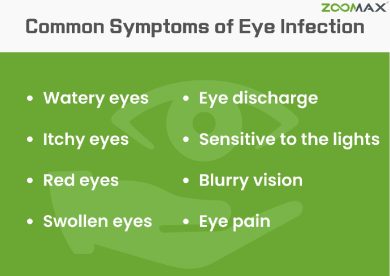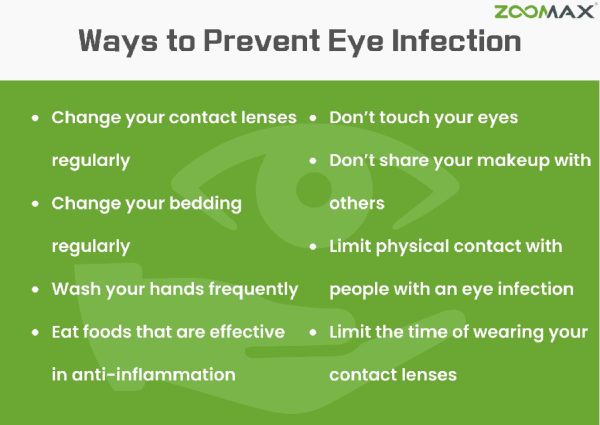 Are you accustomed to rubbing your eyes when feeling uncomfortable? When you use your hands to rub the eyes without paying attention to the hygiene conditions, the germs and viruses would get into the eyes and result in eye infection eventually. Many people don’t take eye infections seriously as they usually can be cured by properly using relevant medications in most cases. However, there are several types of eye infections and some of them may lead to severe visual problems. Read on to get more knowledge about eye infections.
Are you accustomed to rubbing your eyes when feeling uncomfortable? When you use your hands to rub the eyes without paying attention to the hygiene conditions, the germs and viruses would get into the eyes and result in eye infection eventually. Many people don’t take eye infections seriously as they usually can be cured by properly using relevant medications in most cases. However, there are several types of eye infections and some of them may lead to severe visual problems. Read on to get more knowledge about eye infections.
What are the Types of Eye Infections?
Eye infection can be demonstrated in various types, and it will depend on which part of your eyes is infected. Usually, when the viruses enter the eyes, they mostly attack the eyelid, cornea, and conjunctiva. Once one of the three parts is getting invaded by the viruses, the eyes may have signs of red, itch, or pain, and sometimes there are pimples on the eyelids. Meanwhile, according to different types of eye infections, the ocular area that has been infected and the symptoms would vary as well. The common eye infections can include:
- Stye
When something blocks the oil glands that are in the eyelid, small red bumps will grow on the edge of the eyelid, and these bumps are recognized as stye. They can be painful and shelter a part of the vision, and the eyes will constantly feel uncomfortable in this situation. The good news is this kind of eye infection is not contagious and it’s often can be treated by basic medical remedies like eye drops. Sometimes it’s important to distinguish stye from chalazion, which is also an eye condition with pimples on the eyelid. But it’s painless and usually grows on a further edge of the eyelid.
- Conjunctivitis
Conjunctivitis, also known as pink eye, is one of the most common types of eye infection. It’s a highly contagious eye disease and commonly happens among children in classrooms due to the neglect of eye hygiene. In this case, not only the kids but also their teachers have a risk to be infected. This disease often occurs when the blood vessels in the conjunctiva are attacked by viruses or bacteria, however, some people also get it because of allergic reactions. The most obvious symptom of conjunctivitis is the pink eye, and this is where its name comes from.
- Keratitis
It’s a corneal inflammation caused by viruses, bacteria, or parasites in water, or it can result from an eye injury, such as a penetrating injury to the eyes due to a tree branch. People who are accustomed to wearing contact lenses are at higher risk of having keratitis. Thus, washing hands every time before removing the contact lenses from the eyes, changing the lenses on a regular basis, and wearing goggles during swimming is truly crucial to prevent keratitis.

- Uveitis
Uveitis indicates the infection of the uvea, which is the pigment layer of the eye and includes the iris and choroid. Besides viral infections or eye injury, uveitis can also connect with immune-system deficiencies such as lupus. It’s essential to figure out what’s the main cause of uveitis so it can be treated in a proper way. According to different causes of uveitis, the treatment of this type of eye infection can include eye drops, ointment, or oral medications. Also, contact lenses should be forbidden before it’s cured.
- Blepharitis
Blepharitis is an inflammation of the eyelid. It’s not contagious in most cases and won’t lead to blindness. The block in the oil glands at the base of the eyelashes will lead to blepharitis and in the meantime, the edge of the eyelid becomes red, itchy, dry, and swollen. Blurred vision is also a possible sign in this circumstance. Among several causes of blepharitis, wearing contact lenses in an inappropriate way is a leading reason just like other types of eye infection. Therefore, you might realize how important to pay attention to eye hygiene.
- Trachoma
Trachoma is a severe eye infection that can lead to blindness. Although it’s rare in the United States, it still has a higher prevalence in some other countries in the world. Trachoma usually infects the inner eyelid, causing it to begin scarring. The scarring then would cause the eyelid to turn inward and the eyelashes to begin rubbing and damaging the tissue on the cornea, which can lead to permanent blindness eventually. To control the spread of this type of eye infection, eye hygiene is the key measure.

What are the Symptoms of Eye Infection?
The different types of eye infection acquire various symptoms and diverse treatment methods, and they can lead to a variety of consequences. Nevertheless, to some extent, eye infections are usually caused by the neglect of eye hygiene and they can always have some symptoms in common. The common symptoms of eye infection might include:
- Watery eyes
- Itchy eyes
- Red eyes
- Swollen eyes
- Eye discharge
- Sensitive to the lights
- Blurry vision
- Eye pain

In addition to these common symptoms of eye infections, there might be some other situations according to each specific eye infection. For instance, bumps will show up on the eyelid with stye, or people with trachoma would have swollen eyelids differing from the others. Some of the eye infections would have some more detailed types so they can have more performance.
The treatment of specific eye infection will depend on the diagnosis. Take uveitis as an example, as this type of eye infection can result from autoimmune disorders, so the treatment of uveitis might be related to the treatment of specific autoimmune disorders. Of course, to get some of the eye infections treated in an appropriate way, following the instructions of the doctors is quite necessary.
Can eye infection cause 20/200 vision?
 Some people don’t take eye infections seriously as this kind of eye condition seems easy to be cured, and truly some of them can be treated with basic medical remedies. However, among all these types of eye infection, some of them have the possibility to cause legally blind, which may refer to 20/200 vision or poor eyesight.
Some people don’t take eye infections seriously as this kind of eye condition seems easy to be cured, and truly some of them can be treated with basic medical remedies. However, among all these types of eye infection, some of them have the possibility to cause legally blind, which may refer to 20/200 vision or poor eyesight.
As it’s mentioned above, trachoma is a typical example. The World Health Organization (WHO) also delivers the harm of trachoma to the public health. Trachoma shows a high prevalence in 42 countries in the world and causes blindness or visual impairment in about 1.9 million people. Also, based on the statistics of WHO in 2022 June, 125 million people live in trachoma endemic areas and are at risk of trachoma blindness. In addition to trachoma, eye infections like endophthalmitis and cellulitis which are not introduced previously, can also be a factor that leads to 20/200 vision if left untreated. Cellulitis can even lead to worse situations such as meningitis or death.
Fortunately, most eye infections won’t result in irreversible consequences as long as they can be treated timely. Meanwhile, almost all the causes of eye infections are linked to eye hygiene. In this case, to avoid eye infections, paying more attention to eye hygiene is crucial and helpful with good eyesight. Some basic preventive methods of eye infection can include:
- Change your contact lenses regularly
- Change your bedding regularly
- Wash your hands frequently
- Eat foods that are effective in anti-inflammation
- Don’t touch your eyes
- Don’t share your makeup with others
- Limit physical contact with people with an eye infection
- Limit the time of wearing your contact lenses

Eye infection can be a major or minor ocular issue, and it’s determined by how you treat it. In some ways, eye infection is tightly connected with eye hygiene. Ignoring eye hygiene is the leading reason that causes eye infections. Combing with the preventative methods of eye infection, developing a good lifestyle is always important to improve eye health and maintain good vision just as it’s mentioned repetitively. About eye infections, please bear in mind that it’s mandatory to see the doctor immediately when severe symptoms like extreme pain or sudden vision loss appear in your eyes.
References:
https://www.baptisthealth.com/care-services/conditions-treatments/eye-infections
https://www.allaboutvision.com/conditions/eye-infections.htm

